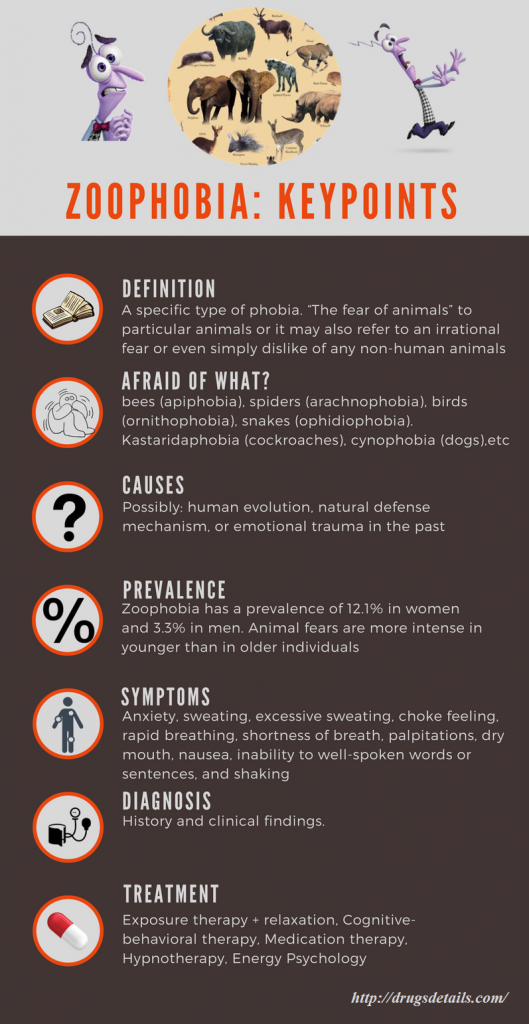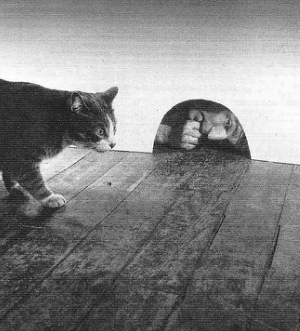Contents
- What is Zoophobia?
- Zoophobia word origin
- What causes zoophobia?
- How common is zoophobia?
- Most common animal phobias
- Signs and symptoms of zoophobia
- Risk Factors for Zoophobia
- Tests to diagnose Zoophobia
- Prevention of Zoophobia
- Prognosis and recovery period for zoophobia or animal phobia
- Zoophobia treatment
- Cognitive behavioral therapy (CBT) for zoophobia treatment
- Medication therapy for zoophobia
- Exposure therapy with relaxation technique for zoophobia treatment
- Hypnotherapy for zoophobia treatment
- Energy Psychology for zoophobia treatment
- Neuro-Linguistic Programming (NLP) for zoophobia treatment
What is Zoophobia?
Zoophobia or “the fear of animals” is a specific type of phobia to particular animals or it may also refer to an irrational fear or even simply dislike of any non-human animals. Zoophobia is one of the most common specific phobias. Most common types of particular zoophobias are entomophobias, such as the fear of insects e.g. bees (apiphobia).
Common zoophobias are also fears of: spiders (arachnophobia), birds (ornithophobia) and snakes (ophidiophobia). Kastaridaphobia (fear of cockroaches), cynophobia (fear of dogs) and musophobia (fear of rats) are also very common. A person may develop zoophobia from dangerous and huge wild animals or even harmless ones; there is no rule for that. According to Sigmund Freud, an animal phobia is one of the most common psychoneurotic diseases among children.
Zoophobia word origin
The word zoophobia comes from the Greek words ‘zōion’ meaning animal and ‘phobia’ meaning ‘fear’.
What causes zoophobia?
According to some researches, it appears that humans have a genetic predisposition to fear of certain animals. To an extent, this fear is necessary for the survival of human species. The severity or extent to which humans fear certain animals is directly associated to the animal’s appearances, fear-evoking properties and their discrepancy from human form. According to most experts there are 2 main causes of zoophobia:
- Human evolution is considered as a primary cause of zoophobia development. Animals have been taken as harmful and dangerous since the earliest civilizations. It is connected to a natural defense mechanism that humans have developed as a survival against animals. As generations passed, certain animals got a spot in our households but many didn’t. However, the fear is incorporated in our genes and may go over the extreme provoking zoophobia
- A traumatic experience. Another significant cause of zoophobia is a previously experienced trauma associated with animals especially in childhood. If the person has a history of animal attacked or hurt or saw someone else getting hurt, then this person can develop zoophobia.
Simply explained some animals are considered as harmless and cute while others as aggressive or wild and there is also a third category of ‘slimy or disgusting’. In majority of the countries where the survey was conducted, it was observed that the ‘disgust relevant animals’ category had a greater fear incidence compared to other 2 categories
In zoophobia, severe anxiety or stress develop in the individual’s mind. Such emotions are usually manifested deep in the brain and are recalled every time the individual is exposed to a stressful situation such as being placed in the same environment.
It is also important to know that not all fears of animals are considered as zoophobia. The latter is a persistent, irrational, unwarranted fear of animals no matter how non dangerous or harmless they are. In other cases, the fear of snakes and spiders can be considered as quite normal and necessary.
How common is zoophobia?
Since there a lot of different animal we can fear of, zoophobia can be considered as a very common type of phobia. Studies showed that zoophobia has a prevalence of 12.1% in women and 3.3% in men. Animal fears are more intense in younger than in older individuals.
According to the data fear of snakes is present in 8,3 % of woman population and 2,4% of man population, while the fear of spiders is 5,3% of woman and 1.2% of man. Seim and Spates study from 2010 showed that most common animal phobias of college students with reports of significant and severe fears were:
- Fear of spiders – Arachnophobia 34%
- Fear of snakes – Ophidiophobia 22%
- Fear of rats – Musophobia 15%
- Fear of insects – Entomophobias 11%
Most common animal phobias
Here is the list of most common animal phobias:
- Ailurophobia – The fear or aversion to cats
- Apiphobia – The fear or aversion to bees (also called as melissophobia)
- Arachnophobia – The fear or aversion to arachnids
- Batrachophobia – The fear or aversion to amphibians
- Chiroptophobia – The fear or aversion to bats
- Cynophobia – The fear or aversion to dogs
- Entomophobia – The fear or aversion to insects
- Equinophobia, hippophobia – The fear or aversion to horses
- Herpetophobia – The fear or aversion to reptiles or amphibians
- Ichthyophobia – The fear or aversion to fish
- Murophobia – The fear or aversion to mice or rats
- Ophidiophobia – The fear or aversion to snakes
- Ornithophobia – The fear or aversion to birds
- Ranidaphobia – The fear or aversion to frogs
- Scoleciphobia – The fear or aversion to worms
Signs and symptoms of zoophobia
Zoophobia might be experienced not only in cases when the individual are faced with the object of his fears but even when the person also thinks of it. Common physical and emotional symptoms of zoophobia may include:
- Feeling dizzy, fainting
- Remaining frozen in place
- Feeling like choking, dying
- Rapid and shallow breathing
- Sweating, trembling
- Experiencing an elevated heart rate
- Trying to flee
- A constant image/movie runs in the phobic’s mind where he imagines being attacked by the animal.
Generally, this phobia may be very debilitating disorder to live with, as the animal or even thoughts of it can create great deal of stress in the sufferer’s mind. Some phobics even go to the extremes of refusing to leave their home for fear of encountering the animal.
Risk Factors for Zoophobia
Zoophobia can occur in people of all the ages whether children or adults. However there it is most common in women and children. History of anxiety disorder or any mental disorder may increase the risk of this phobia
Tests to diagnose Zoophobia
There are no special tests to diagnose zoophobia. History of phobia, and signs and symptoms are most commonly enough to diagnose this specific phobia. Zoophobia makes a negative impact on person’s life, thus by doing some different analysis you can clearly able to identify whether you are suffering from zoophobia or not.
Prevention of Zoophobia
Zoophobia or animal phobia can be prevented at an early stage with self-care and with the help of health professional. Reprogramming mind with positive thoughts about animals is a good way to prevent zoophobia or animal phobia. Patients need to adapt to the situations with positive thoughts and thinking patterns.
People suffering from zoophobia can cope with fear by keeping themselves away from stressful situations. They should make create mental visualization and act positively. Under the guidance of a skilled mental professional, they can handle animal phobia proactively through confronting their worries. Friends and family members may also give you psychological support to reduce emotional distress and phobia.
Prognosis and recovery period for zoophobia or animal phobia
The prognosis of zoophobia is most commonly good. Treatment at early stage can be very effective for recover from zoophobia or animal phobia through controlling the anxiety levels, overcoming fears and taking other considerations. If possible, try to refresh your mood with the positive ways and things that can divert your mind from such negative influences.
Zoophobia treatment
Following treatment options may be considered in patients with zoophobia:
- Exposure therapy + relaxation
- Cognitive-behavioral therapy
- Medication therapy
- Hypnotherapy
- Energy Psychology
- Neuro linguistic therapy
Cognitive behavioral therapy (CBT) for zoophobia treatment
CBT is related with thoughts and behavior modification of a person. The therapist will have regular counseling sessions with the patients in the context of the fear for animals, and will try to discover and understand the inner causes/thoughts responsible for it.
The therapist guides the patient how to understand the phobia in order to build a positive behavior. The final goal is to release the stress and anxiety, and to gain more confidence to face their fear of animals.
This therapy can learn you:
- What factors may trigger your panic attack or similar symptoms and what makes them worse
- How to deal with and overcome symptoms of anxiety
- Specific ways to directly overcome your worries, such as the likelihood of bad things that may happen in social situations
- Anxiety gradually lowers if you remain in situations
- How to change unhealthy or unwanted behaviors via desensitization in order to safely face the places and situations that cause fear and anxiety
Medication therapy for zoophobia
In severe cases, medications can also help with controlling the fear and anxiety. Most commonly prescribed medicines are anti-anxiety and anti-depressant drugs that balance brain chemicals such as serotonin which is responsible for the mood and temperament of a person.
Drug choice and appropriate dosage are based on considerations of: safety, efficacy, severity and frequency of symptoms, comorbidities and the personal needs of the patient.
Antidepressants for zoophobia treatment
Tricyclic antidepressants are older than SSRIs and are as effective as SSRIs for anxiety disorders. Imipramine is the tricyclic antidepressant that is most commonly used for this condition.
Imipramine is usually started with small daily doses that are increased on every few days until the most effective dosage is achieved. Such slow introduction of this drug will help in minimizing side effects such as constipation, dry mouth and blurred vision. Amitriptyline (Elavil) or nortriptyline (Pamelor) is also commonly prescribed.
SSRIs works by altering the levels of serotonin in the brain, which like other neurotransmitters, helps brain cells to communicate with one another.
Fluoxetine (Prozac), escitalopram (Lexapro), sertraline (Zoloft), paroxetine (Paxil), and citalopram (Celexa) are most commonly prescribed SSRIs for panic disorder, PTSD, OCD and social phobia. SSRIs are also prescribed to treat panic disorders when they are accompanied with OCD, social phobia, or depression. Similarly to TCAs, these drugs are also started with low doses and gradually increased until they reach beneficial effect.
Tricyclic antidepressants should be used in combination with exposure therapy or cognitive behavioral therapy. A combination of antidepressants and cognitive behavioral therapy has been shown to be the most effective treatment for zoophobia.

Anti-anxiety drugs for zoophobia treatment
The high-potency fast-acting benzodiazepines drugs including: alprazolam, clonazepam, and lorazepam are commonly prescribed for the effective acute relief of anxiety. They act rapidly, and except the risk of dependency and some side effects, they are well-tolerated by the majority of patients. Common side effects may include: confusion, light-headedness, drowsiness, loss of balance, and memory loss.
Exposure therapy with relaxation technique for zoophobia treatment
This is probably one of the most effective psychotherapies for treating zoophobia. In exposure therapy, the patient needs to resist fearful situations involving animals or their images. The therapist will also teach the patient relaxation techniques such as breathing control, mental visualization and medicines to cope with the anxiety during the exposure to animals. The most important goal of exposure therapy is to slowly build toleration in the person towards their fear.
Hypnotherapy for zoophobia treatment
Hypnotherapy may be also helpful for zoophobia treatment. The patient is gradually exposed (and consequently desensitized) to animals and/or animal images in a controlled fashion so as to be able to manage the feelings of panic that occur and slowly gain confidence to deal positively with the situation.
Energy Psychology for zoophobia treatment
Energy psychology has been shown as an excellent therapy for fears and phobias because in studies it is shown to be rapid, safe, effective and long-lasting. It is established on a theory and practice that has been around for a couple of thousand years.. Energy psychology may lead to:
- Quickly and easily change your behaviors.
- Thought patterns change, often very quickly.
- Developing skills and techniques that are useful for a lifetime in all situations.
Neuro-Linguistic Programming (NLP) for zoophobia treatment
NLP is principally the practice of how we create our reality. From the NLP viewpoint, a phobia is the result of your programs or “constructs” that you have created that don’t work very well. With NLP, these constructs are revealed and “re-programmed” so that the Zoophobia is minimized and often eliminated. Usually the interventions are quite rapid and effective
“What is the fear of your mother-in-law called? Is it real? What are the signs?“


